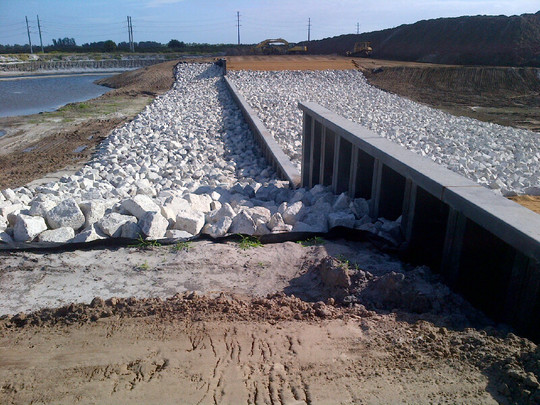FOR IMMEDIATE RELEASE: Nov. 1, 2013
DEP, SJRWMD TOUR NORTHERN IRL TO DETERMINE PLACEMENT OF REAL-TIME MONITORING DEVICES
~Staff looks for opportunities to reduce pollution sources, improve water quality~
 The 275-acre Wheeler Stormwater Park in Brevard County is designed to improve the quality of water discharged to the North Prong of the St. Sebastian River.
MELBOURNE – This week, Florida Department of Environmental
Protection Deputy Secretary Drew Bartlett and other Department water quality
restoration program staff joined St. Johns River Water Management
District Executive Director Hans Tanzler and staff as well as the Indian River Lagoon National
Estuary Program and the Indian River Lagoon Aquatic Preserves for a tour
of the northern lagoon to view areas of concern in the basin and discuss
potential solutions and project ideas.
One particular area of focus was the discussion of the
deployment of real-time monitors in the basin. The Department will be
investing $1.7 million statewide in the equipment and
partnering with the water management districts to manage the monitors, once installed. The Indian River Lagoon, along with springs is the top priority for this equipment to be deployed.
“The recent algae blooms in the
Indian River Lagoon have been devastating. Deploying this new technology
on Indian River Lagoon and other waterbodies statewide will give us a lot more
information on cause and effect relationships when we have a harmful algal
bloom,” said Bartlett, Deputy Secretary for Water Policy and Ecosystem Restoration. “We must also diligently look
for opportunities to further reduce nutrient pollution in this incredibly
valuable state resource.”
In February, the Department adopted three basin management action plans
-- or restoration plans -- for the Indian River Lagoon, after
determining pollutant load reduction targets based on sound science. Research identified
stormwater as the primary source of nutrients to the Indian River Lagoon and is confident
the projects in these restoration plans will result in significant water
quality benefits.
The plans account for more than $300 million invested or to be invested
in wastewater and stormwater infrastructure, along with urban and
agricultural best management practices. As the plans are implemented,
additional projects will be developed. More will be needed to control
nutrient inputs to ultimately restore this valuable waterbody. In August, the Department hosted a
meeting to update stakeholders on water quality modelling data, research and seagrass monitoring data.
"The Department continues to collaborate with local stakeholders
to achieve water quality benefits for the Indian River Lagoon,” said Tom Frick,
Director of DEP’s Division of Environmental Assessment and Restoration. “The
opportunity to increase monitoring, specifically with real-time equipment, will
help all stakeholders make any needed adjustments to the BMAPs in order to
achieve restoration and help reduce algal blooms.”
As part on ongoing efforts, the Department, the water management districts, Indian River Lagoon National Estuary Program,
federal and state agencies, local governments and educational institutions are
individually and collectively working to find answers to the cause of algal blooms and to identify what, if anything, can be done in the future to
limit or avoid a similar event.
Chief among this
work are the Indian River Lagoon 2011 Consortium and the District’s Indian
River Lagoon Protection Initiative. The Initiative is being developed to better
understand the sources, cycling and transport of lagoon nutrients and the
long-term impacts from the loss of the lagoon’s seagrasses, as well as
potential strategies aimed at restoring the lagoon to a seagrass-dominated
ecosystem. The real-time monitoring equipment is critical to the success
of this effort.
“We are pursuing action-oriented solutions that accelerate
long-term benefits to the Indian River Lagoon,” said Tanzler. “This requires
collaboration at all levels of government and with our stakeholder partners.”
|